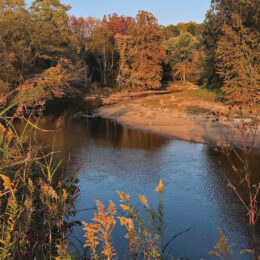 For years, I covered the bass fishing tournaments in the Midwest for a now defunct bass fishing magazine.
For years, I covered the bass fishing tournaments in the Midwest for a now defunct bass fishing magazine.
Like the hundreds of anglers I interviewed, I, too, believed the largemouth bass to be one of the smartest fish swimming: an opponent which could be taken consistently only by an angler with Yoda-like knowledge. Only a sound understanding of lure selection, color, presentation, rigging of terminal tackle accompanied with a highly refined, instantaneous hook-setting reflex could ensure a positive hookup in the vast variables found in organized piscatorial pursuit.
Like the 150-horse-propelled tackle junkies with their backward-camouflaged baseball caps streaking across America’s shining fresh water from sea-to-sea, I am also a catch-and-release angler. I’m a devoted believer in preserving our challenging natural resource for generations of bass anglers yet to be.
So it was like getting hit with a bucket of ice water on a hot summer day when I stumbled across the scientific truth of bass fishing and the horrifying possible end result of catch-and-release angling.
According to a 20-year scientific study of bass angling on a lake, research has determined bass anglers are catching the dumb bass. Not only are they catching the dumb bass, but they are catching the dumb bass over and over. The dumber the bass, the more they are caught.
Here’s the genetic horror story … With catch-and-release angling, the dumb bass caught are released unharmed. This allows the dumb bass in turn to raise broods of baby bass with a tendency to grow up to be dumb bass like their parents. In short, anglers are unknowingly stocking the shallow end of the gene pool with dumb bass which are easily fooled over and over — and are easy to catch.
To answer the first question: No … I did not make this up.
In the experiment, researchers at the University of Illinois found vulnerability to being caught by anglers is a trait which can be inherited in largemouth bass. The study began way back in 1975 with the resident population of bass in Ridge Lake, an experimental study lake in Fox Ridge State Park in the east-central Illinois city of Charleston, just north of I-70 west of Terre Haute.
The fishing was controlled. For example, anglers had to reserve times, and every fish caught was put into a live well on the boat. The fish were measured and tagged to keep track of how many times each fish had been caught. All fish were then released.
“We kept track over four years of all of the angling that went on, and we have a total record – there were thousands of captures,” said David Philipp, ecology and conservation researcher at U of I. “Many fish were caught more than once. One fish was caught three times in the first two days, and another was caught 16 times in one year.”
After four years, the pond was drained, and more than 1,700 fish were collected. “Interestingly, about 200 of those fish had never been caught, even though they had been in the lake the entire four years,” Philipp said.
Males and females from the group that had never been caught were designated Low Vulnerability (LV) or hard-to-catch parents. To theoretically produce a line of LV offspring, these parents were allowed to spawn with each other in university research ponds. Similarly, males and females that had been caught four or more times in the study were designated High Vulnerability (HV) or easy-to-catch parents that were spawned in different ponds. The two lines were then marked and raised in common ponds until they were big enough to be fished.
“Controlled fishing experiments clearly showed that the HV offspring were more vulnerable to angling than the LV offspring,” said Philipp. The selection process was repeated for several generations over the course of the 20- year experiment.
The only variation to what could become a plague of easy-to-catch bass because of year-round catch-and-release happens during the spawning season when the males are guarding the young bass. When the male is taken away from the school of fry, the young ones are quickly subject to predation. In short … while the anglers are whisking the easy-to-catch, guardian daddy fish off to the tournament weigh-in site in their live wells to be weighed and released later in the day, all of the easy-to-catch baby bass get eaten.
Some of the research personnel apparently were bass anglers. Their recommendation was to immediately release all bass during the spawning season when the males are guarding the young. Doing so will keep the school of young ones from being gobbled up. I’m all for it! Remember, with the practice in effect, all the little bass being saved are the ones who will be easier to catch in the future.
If you plan on sharing the information, I’d suggest when you see a successful bass angler don’t start the conversation by blurting out, “I see you caught a few dumb bass!” Insulting the intelligence of a bass fisherman’s catch is not a good way to get off on the right foot, and could lead to a right hook.
I can’t help but wonder what it would be like to catch one of the bass that never gets caught?
Jack Spaulding is a state outdoors writer and a consumer of RushShelby Energy living along the Flatrock River in Moscow. Readers with questions or comments can write to him in care of Electric Consumer, P.O. Box 24517, Indianapolis, IN 46224; or email jackspaulding@hughes.net.



